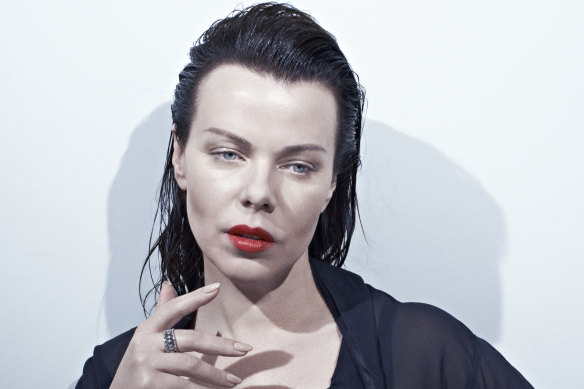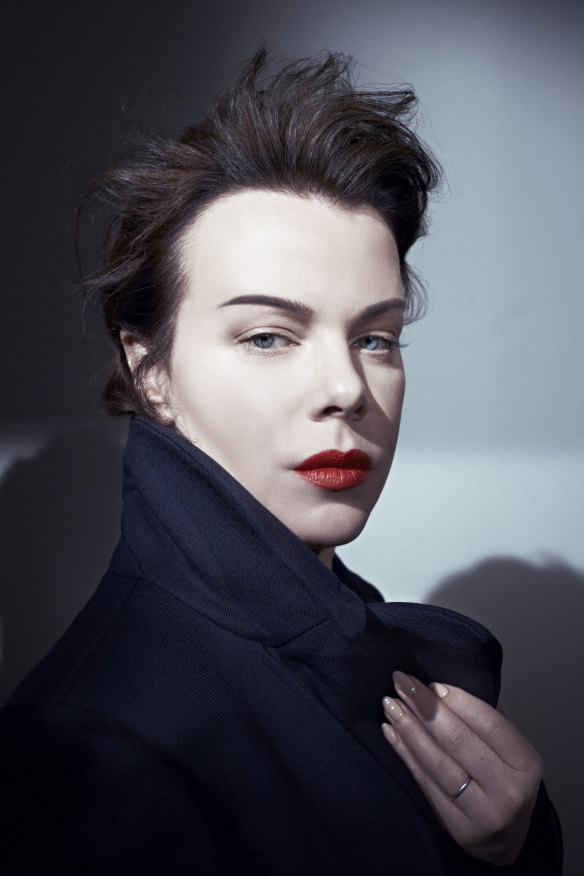This was published 1 year ago
Raised by single women who had to leave bad men, Debi Mazar beat the odds
How the New York It girl and best friend of Madonna hustled her way to Hollywood.
By Steve Dow

Debi Mazar is starring in the new ABC drama, Ladies in Black.Credit: Arkan Zakharov/Contour by Getty Images
Actor Debi Mazar picks up the binoculars gifted to her when her TV series Younger wrapped and looks for birds hiding among the olive and cypress trees that surround the 11th-century, medieval Florentine home she shares with her Italian husband, chef Gabriele Corcos.
The couple moved permanently to Florence during the pandemic – Mazar had always promised Corcos’ mother she would “bring him home some day”. They fled the grit of New York City, which Mazar has always loved, for this quieter spot to raise their daughters Evelina and Giulia, embracing European art, culture and languages along the way.
Like the birds she watches, Mazar, 59, and Corcos, 51, are about to become empty nesters as their progeny take flight. Evelina, 22, is decompressing in Miami after working as a wardrobe assistant on singer Madonna’s recent tour, while Giulia, 18, is soon to be an international baccalaureate graduate and will take time off to travel.
It’s a Wednesday morning in early May, and the next day Mazar will jump on a high-speed train to Rome to table-read a script with the cast of the thriller series Iris. She most recently portrayed a modern-day Medusa with a New York accent beneath a head of animated snakes in Netflix’s upcoming comedy series Kaos, a retelling of Greek mythology, alongside Jeff Goldblum as Zeus. But soon she’ll be seen as Magda, a stylish Polish émigrée working in a Sydney department store in 1961, in the new ABC drama, Ladies in Black. Adelaide stood in for Sydney for the series – its heritage buildings ideal for outdoor shots.
For her time in Adelaide, Mazar made sure she packed her knife roll – she is a collaborator with Corcos on cookbooks, a food website and a TV show called Extra Virgin – and the Australian city was a “food paradise” revelation for her as she snapped up meats and cheeses at its markets.
Mazar also bought a bird feeder to provide seed to the chirping lorikeets and squawking cockatoos that woke her daily at her Adelaide rental home. (She says a treasured image in her collection of photographs is a Leila Jeffreys portrait of a black cockatoo named Rosie.) But while she loved the bird life, Mazar was not a fan of Australia’s insects and spiders – an odd disposition given her hobby of collecting and displaying dead butterflies and bugs.
Human Australians, however, were more appealing. “I found Australians to be very salt-of-the-earth,” she says, wearing a shiny black sarong with floral print, and slicked-back hair. The number 13 is tattooed on her left wrist. “The women are of strong stock, they can just pick up bugs, and the energy is great. The wit! The laughter! Not as dry as Brits – almost the opposite.”
Ladies in Black is directed by Gracie Otto, and is a spinoff of the 2018 Bruce Beresford film of the same name, which itself was adapted from the 1993 Madeleine St John novel, The Women in Black. It comes with a strong, feminist energy as it features working women fighting to break free from patriarchal bonds.

Mazar hustled to cool stardom via New York’s late 1970s and early ’80s art and fashion scene, and was named by New York Magazine as an “It girl”.Credit: Arkan Zakharov/Contour by Getty Images
Mazar’s character Magda is a believer in equality rather than hierarchy, and is a mentor to the younger staff in the fictional Goodes department store. Mazar decided to make the character Polish, and watched the movie Sophie’s Choice over and over to see how Meryl Streep nailed the accent. “She was so glorious but it’s the worst thing I could have done,” Mazar admits. “Once you’ve watched Streep you’re like, ‘Oh god, why am I even an actress?’ ” she laughs.
Magda dreams of owning her own boutique, but Mazar gave her an even bigger backstory. She imagined she had been married to someone Jewish during the war, and had lost a baby. Mazar took inspiration from her own Latvian paternal grandmother, Austra, a Catholic who stayed in Latvia during the wartime occupation by the Soviets, then the Germans.
Austra’s Jewish husband – Mazar’s grandfather – fled the country, never to be seen by the family again, while Austra, pregnant with Mazar’s father, was forced by the Nazis to go to Germany to work as a nurse. She later settled in New York but suffered post-war trauma for the rest of her life.
“I was raised by single women,” says Mazar, toying with a dangling, large gold earring. “My grandmother – an angry grandmother – was a single woman. They had to struggle, leave bad men, start over, and raise kids on their own.” According to Mazar, Austra was also a “sex bomb, with platinum hair and very chic”.
But Mazar’s sense of style in creating Magda was influenced more by her maternal grandmother, Evelyn. She did most of the work raising Mazar, and used to dress impeccably in Lilli Ann suits with shoulder pads, good shoes, stockings, garters and jewellery.
Mazar recalls sitting up late at night with Evelyn watching old Hollywood films on a black-and-white TV set. Most memorable was the 1939 film The Women, starring Norma Shearer and Joan Crawford, as well as Bette Davis and Carole Lombard classics, film noir and musicals. Mazar recalls admiring the actors’ fabrics and the cuts on the bias. “I’m a Leo, so I like to sparkle,” she says of her style inheritance.
Mazar’s mother, Nancy, had given birth to her at 15, and her mother’s young friends became de facto aunts – Puerto Rican women who worked as strippers with go-go boots and fishnet stockings. Nancy became a hippie. “I was completely the opposite of my mum,” Mazar recalls.
“There were girls [like me] who dressed up different and did their hair different … I was a little chunky, and I didn’t have any money.”
DEBI MAZAR
Mazar moved in with her godparents on Long Island for a couple of years, then, when nearly 16, she moved to the city. “My early teen years were very difficult,” she recalls. “It was time to go. I couldn’t live with my mother any more, and also, the world felt safer, even though it was the mid-to-late ’70s. New York was a different place, so rents were cheap, and to survive and get a job, you didn’t necessarily have to show ID. There was no checking.
“Even with my acting, when I first started out, I created my resumé – I’d bullshit, bullshit, bullshit – and little by little, I was able to put real stuff on it. But, you know, you had to be savvy, you had to have the hustle.”
Mazar worked as a VIP door person at the Mudd Club, then Danceteria. “There were all these boys who were gay who came from all over the world to New York City, and there were girls [like me] who dressed up different and did their hair different … I was a little chunky, and I didn’t have any money.”
She hustled to cool stardom via the city’s late 1970s and early ’80s art and fashion scene, and was named by New York Magazine as an “It girl”.
After cutting her hair into a short, punk-style after a dye mishap, she started assisting others with hair and make-up. She styled Andy Warhol’s wig and shared an apartment with painter Jean-Michel Basquiat. She also dated the pop surrealist artist Kenny Scharf.
One day in the early ’80s, she met Madonna in a lift. The future pop star was carting around a cassette of her music, and was then “just a cute girl from the Midwest bouncing around New York, though she had this raw sexual energy”. Mazar would go on to help Madonna create a look just as the singer’s chameleonic fame began.
The friendship has lasted decades, with Mazar recently joining Madonna on stage in Milan during the song Vogue. “It was like old times, being able to laugh and smile. You know, I introduced her to the ‘voguers’. Back in the day, I was like, ‘You’ve got to meet these kids, these dancers they’re amazing’. We both went through losing our friends; we had a lot of the same friends, and we both went through going to hospices.”
From her late teens, Mazar lost many young, close friends to AIDS. It profoundly affected her and her eyes still well up at the memory: “Those of us who didn’t die were like, ‘Oh my god, I can’t believe we’re here.’ ” Today, she is insistent that people celebrate and be grateful for getting older.
Mazar’s visit to Australia last year to make the series was her first trip to the country and a long way from her years as a VIP door person in nightclubs. Her life in Florence, which began in 2001, is also a long way from her teenage times. Mazar was on holiday when she met her husband, who was sent by an Italian friend to pick her up from the airport. “He was really cute, and when I saw him, it was like sun rays were coming out of his head.”
The following night, ducking out of a party together for cigarettes and cocktails, they sat on the steps of a 12th-century church in Santo Spirito. “We talked for two hours non-stop, and we had this crashing of the minds. We went back to the party, and he said, ‘You’re fantastic, we should have kids together’.
“I was like, ‘Excuse me? What sort of line was that? Oh, my god.’ ”
Years later, Mazar would caption a photo of Corcos on his motorbike in helmet and leathers as: “I married adventure!” She could just as well have been describing her own life.
Ladies in Black premieres on ABC-TV and ABC iView on June 16.
Make the most of your health, relationships, fitness and nutrition with our Live Well newsletter. Get it in your inbox every Monday.